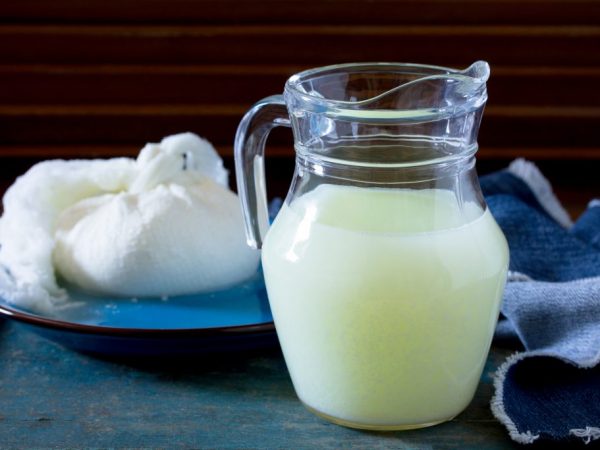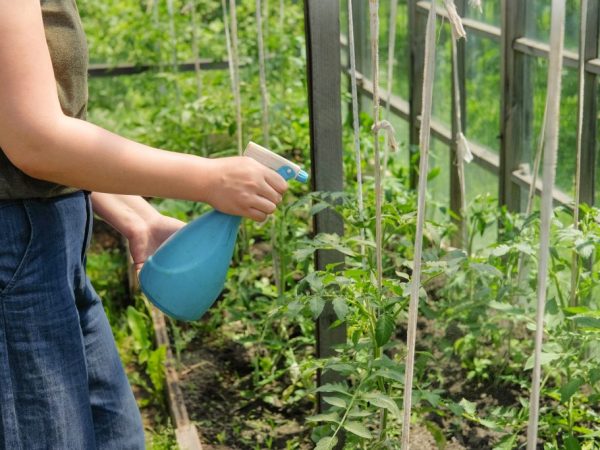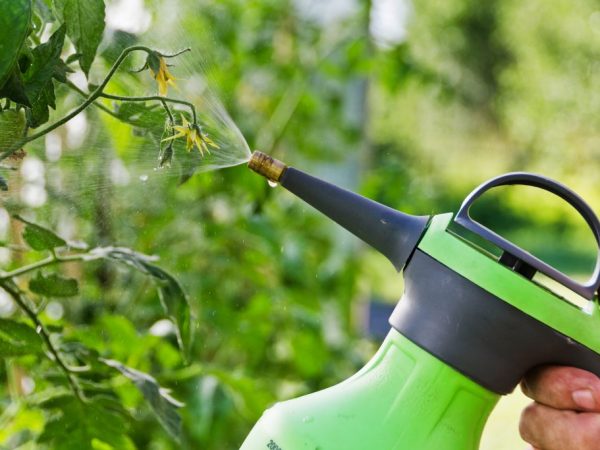How and why to spray tomatoes with whey
Fertilizing plants for a good harvest is the primary task of any gardener. Useful tomato serum replaces purchased fertilizers and is safe for humans. Homemade feeding can be done independently from waste dairy products.

Spraying tomatoes with whey
The benefits of whey for tomatoes
Spraying tomatoes with whey is carried out several times a month. This procedure does not harm the fruits and neighboring crops. Tomato and Cucumber Whey is a versatile agent and fertilizer. Properly organized watering and feeding of tomatoes with whey guarantee a good harvest in the fall.
You can spray tomatoes with whey both in greenhouses and directly on an open land. With the help of waste dairy products, they organize the treatment of sick bushes that have suffered from parasites or fungal diseases. Serum for cucumbers and tomatoes is used as a main or complementary food.
The biggest danger to tomatoes and cucumbers (seedlings and bushes) is late blight. A dangerous disease destroys seedlings in a few days and infects healthy bushes. The plant is difficult to save, and the entire future crop is under threat of destruction. If you fertilize the soil and the root system of tomatoes and cucumbers in a timely manner, this problem will not arise. It is very profitable to process bushes with whey: you can make a cheap natural product with your own hands.
Folk remedies for tomatoes
Fertilizing on a natural basis - especially useful for crops in the fall, when the plants lack moisture and vitamins. For feeding vegetable bushes, processed fermented milk products with a high content of amino acids are often used. Folk recipes will help strengthen the plant's defense mechanisms:
- Milk contains useful trace elements and substances that replace immunomodulators for plants: such substances help to strengthen the stems of plants and their root system.
- Serum amino acids help seedlings grow rapidly, and lactose fights pests.
- Monoacid bacteria additionally protect the leaves of the culture from the multiplication of pathogenic microorganisms.
- The microflora of products allows you to destroy existing bacteria: fermented milk fertilizer cleans the surface of leaves and stems from fungus.
- A milk-based tomato feed is used a few weeks before harvest to strengthen the emerging ovaries.
What is good about milk feeding? Feeding with milk creates an invisible but durable protective layer. Thanks to the formed film, tomatoes are not affected by fungi and dangerous diseases.
Cultured stalks and rhizomes are processed with fermented milk products. Dairy dressing is absolutely safe for humans and does not affect the quality of the harvested crop.
How to feed milk
Seedlings at any stage of development can be treated with whey. The processing of the plant takes place according to a clearly painted scheme: the stems and leaves are sprayed every ten days or three times a month. For resistant strong crops, the number of sprays is reduced to once a month. Experienced gardeners recommend sprinkling seedlings every week.

Plants can be sprayed at any stage of growth
The more often you can process tomatoes or cucumbers, the more you will need a natural dairy product. You cannot use a concentrated product for fermented milk fertilizer. For plants, solutions are selected in which the share of dairy products is only 50%. You can dilute the fermented milk mixture (milk distillation residues) with purified water or useful liquid additives. The proportion 1: 1 is the best option for seedlings and tomato bushes.
To obtain fermented milk fertilizer, you can use cottage cheese or stale kefir. The filtered product is immediately diluted with water (room temperature). The resulting solution should be sprinkled on the entire visible part of the plant and fertilized to feed the root system.
Top dressing additives
The benefits of dairy products can be even greater if the gardener adds equally useful substances to the finished solution. Supplements such as iodine or live beneficial bacteria will strengthen the culture against any seasonal disease.
The drug "Fitosporin" is used as an independent feeding. Solutions with live bacteria are often added to fermented milk products. If you spray seedlings with such an enriched fertilizer, no mold is scary for seedlings.
Universal Vegetable Whey Recipe
Comprehensive measures are needed to strengthen tomatoes. Watering should be alternated with the planned feeding with special homemade solutions. To prepare an enriched mixture with iodine, you will need:
- 10 liters of water;
- 2 parts whey;
- a few drops of iodine (no more than 10 drops);
- a small handful of wood ash.
Separately, each component of the solution is useful for the growing culture. Water is the necessary moisture, acidic solution and iodine are strengthening substances for the stems, and ash enriches the soil with the necessary nitrogen. Thanks to the combination of all components, the mixture prolongs the fruiting of the culture, and the ripe fruits do not rot or darken.
Top dressing with iodine is used for the root system and the green part of tomato bushes. For the best effect, you can alternate therapeutic measures: casting treatment is carried out every 10 days using a simple serum, and with iodine it is worth treating the roots of tomatoes once a month.
Concentrated solution with iodine
If the plants begin to hurt: the legs darken, a fungus appears on the stems and the leaves dry, the gardener needs to take emergency measures. In such cases, a simple serum is indispensable. You need to process the roots and stems of tomatoes with a concentrated fertilizer, which is prepared according to a simple scheme:
- to process all vegetables, you will need half a liter of fresh dairy products;
- milk processing waste must be heated to room temperature;
- 10 drops of iodine are added to warm serum.
Spraying with a solution is carried out daily. The leaves of tomatoes and cucumbers are especially carefully wiped. Mold treatment is carried out in addition to other measures: removing diseased plants and replacing contaminated soil.
A concentrated solution for cucumbers and tomatoes in the form of seedlings or adult bushes is suitable. The fruits of cucumbers or tomatoes do not suffer, but it is better to spray them with a simple mixture diluted in water.
Bushes processing
Every prudent gardener needs to know how to spray tomatoes with whey. The prepared mixture should not be stored for more than two days, otherwise fermented milk products will only harm the culture.For peppers, cucumbers and tomatoes, a natural fertilizer is used in the warm and cold seasons. A fermented milk solution is useful for greenhouses and hotbeds. The tomato serum is sprayed with a conventional spray bottle. The first treatment is carried out immediately after planting the seedlings in pots. From this period, the bushes need additional protection.

Serum will help strengthen plant immunity
Spraying continues after planting the bushes on open ground. Plain whey will strengthen the immunity of plants and allow them to bear fruit well in the future. The components of the solution are diluted immediately before spraying and used immediately. Sprinkle tomatoes with whey for active growth with the addition of "Fitosporin".
How to properly spray plants
Spraying tomatoes requires a whey to water ratio. If you dilute the solution in a ratio of 1: 1, the solution will not harm weak seedlings. Such spraying does not give a long-term effect, therefore, after treatment, it is impossible to pull with repeated protective measures.
Spraying tomatoes with whey is carried out on days of good weather. If spraying is carried out during rains, there will be no effect from the product. To make tomatoes grow faster, processing must be combined with replenishing the soil with wood ash or natural fertilizers. Top dressing of tomatoes using natural milk whey is beneficial on large plantations and small land plots (saving the gardener's money).
Disease prevention
Spraying of vegetable bushes is carried out during seasonal diseases and for the prevention of dangerous diseases in plants planted in open ground. Processing is always cheaper than treating tomatoes for fungi or pests. Tomatoes, which are treated with serum, do not get sick in a timely manner and allow you to harvest a good harvest in the fall.
For prevention, the processing of vegetable bushes is carried out after cleaning the bushes from dry leaves and rotten stems. You need to start spraying the culture in greenhouses while the stems are still not strong. Prevention can be carried out less frequently than spraying the crop during the disease. It is enough to spray the tomatoes once a month and organize constant watering in order to harvest a good healthy harvest by autumn.
Conclusion
It is not enough just to water the tomatoes after the seedlings have been planted. Seasonal diseases and pests are a problem that every gardener can face. A dairy product obtained from spoiled kefir or milk can be used as a means of fighting any disease and fungus. Spraying tomatoes with this whey is absolutely safe for humans.
With the help of milk processing waste (with additives or diluted with plain water), diseases that kill young ovaries or fruits can be destroyed. Safe fertilization will protect the stems and roots of the shrubs. Regular treatment with serum will preserve the seedlings and protect the bushes from environmental threats. Every gardener should know that the principle of "water, fertilize, saturate" always works on crops such as tomatoes and cucumbers.



